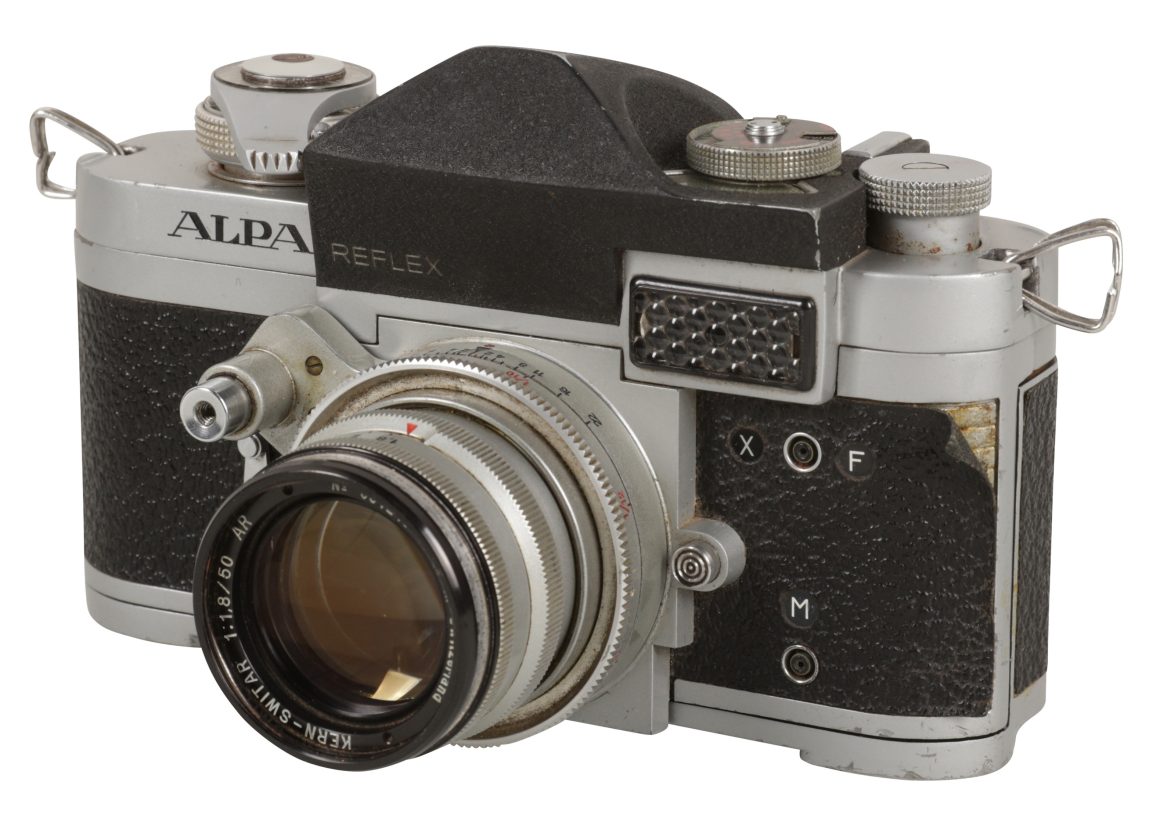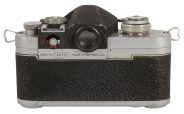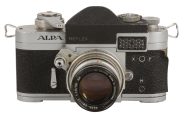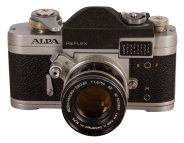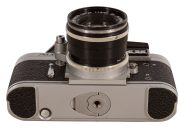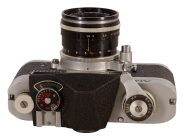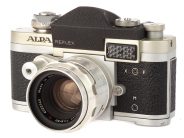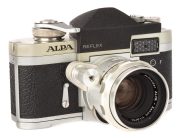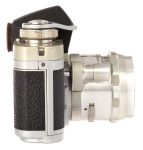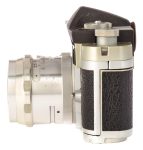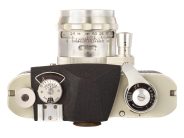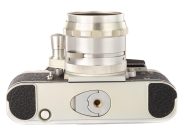Alpa Reflex 6c
35mm MF film SLR camera • Collectible
Specification
| Production details: | |
| Announced: | 1960 |
| Production type: | Small-batch production |
| System: | ● Alpa (1952) |
| Format: | |
| Maximum format: | 35mm full frame |
| Film type: | 135 cartridge-loaded film |
| Mount and Flange focal distance: | Alpa [37.8mm] |
| Shutter: | |
| Type: | Focal-plane |
| Model: | Mechanical |
| Speeds: | 1 - 1/1000 + B |
| Exposure: | |
| Exposure metering: | Through the separate window |
| Exposure modes: | Manual |
| Physical characteristics: | |
| Weight: | 680g |
| Dimensions: | 146x95.3x50.8mm |
Manufacturer description #1
LIGHTNING REFLEX AND HAIR-TRIGGER RELEASE END ALL IMAGE BLACK-OUT
The NEW ALPA 6c ALL-IN-ONE 35 mm camera
With "six gun" or 35 mm camera - split-second reflex control still remains the "mark of the master".
The new ALPA 6c with Lightning Reflex Mirror and Hair-trigger Release gives you this complete image control - automatically. Your lifesize groundglass with built-in rangefinder gives you absolutely accurate framing, focusing and depth-of-field control, without black-out.
Manufacturer description #2
ALPA introduces the NEW version of their model 6
Now you have the option of straight 0° viewing or convenient 45° viewing (an ALPA exclusive)...
The COMPACT, LIGHTWEIGHT, STREAMLINED ALPA 6c with built-in exposure meter!
... available in chrome or deep satiny black finish.
The ALPA formula:
Swiss chronometer precision + custom ground optics = unconditional guarantee for highest mechanical and optical performance.
Which do you prefer?...
New: Rapid, straight 0° Viewing, the traditional way, with the ALPA 6c
or
Convenient 45° Viewing, the natural angle for reading, with the other ALPA models. Allowing a completely relaxed position of the head without nose interference, it is the ideal camera for wearers of glasses, low angle shots, close-up and copy work, photomicrography, and overhead shots.
- The ALPA is a triumph of Swiss precision: Each ALPA is as painstakingly assembled as a fine Swiss watch, literally custombuilt to your order with all the skill and experience of the Swiss watchmakers.
- Ultrafine groundglass gives a strikingly brilliant, 1:1 lifesize image of exactly 23x35 mm, i.e. 1/2 mm less on each side than 24x36 mm frame, a margin covered by the 2x2 slide mounts.
- New: Built-in exposure meter in ALPA 6c, for direct readings of exposure time and diaphragm or Optical Viewfinder or combined Multifocal Viewfinder/separate Rangefinder (ALPA 8) in all other ALPA models. Metraphot exposure meter can be attached to accessory clip, fits into eveready case.
- New: film reminder dial of ALPA 6c indicates black and white, color negative, color positive (reversal) indoor or outdoor film.
- Vibration-free shutter, controlled by Swiss precision movement, offers M, F and X-synchronization (up to 1/64), selftimer (1-20 seconds), electronically tested speeds from 1/1000 to 1 second and B, plus intermediate speeds between calibrations: 60 different settings!
- Frontal rapid wind lever (optional), for fast film transport without removing camera from eye. Model 6c is always furnished with lever.
- New: unique pull-out rapid rewind crank, for highspeed rewinding.
- New: Release button returns exposure counter automatically to zero.
- New: Recessed eyelets accept roundshaped, braided leather neckstrap.
- The only complete set of 10 lenses with Automatic Diaphragm: 24 mm - 28 mm - 35 mm - 50 mm - Macro-Switar 50 mm - 90 mm - 100 mm - 135 mm - 150 mm - 180 mm! Other lenses range up to 500 mm Super-Telephoto.
- Automatic diaphragms close and open automatically, work with bellows and extension tubes (twin cable release), can be disconnected for checking depth-of-field or use of selftimer.
- 35 mm f 2.8, Macro-Switar 50 mm f 1.8 and 135 mm f 3.5 lenses have Automatic depth-of-field indicators.
- ALPA APOCHROMATS: Switar and Macro-Switar 50 mm f 1.8, Kinoptik 100 mm f 2 and 150 mm f 2.8 highspeed APOCHROMATS offer exclusive correction of all primary colors, for lifelike color rendition.
- ALPA ALL-IN-ONE lenses: Macro-Switar 50 mm f 1.8 APOCHROMAT focuses from infinity to 2", Makro-Kilar 40 mm f 2.8 from infinity to 4" or 2" and Makro-Kilar 90 mm f 2.8 from infinity to 5", without accessories! Reproduction ratios and exposure factors are calibrated on lensmount.
- ALPA Close-up and Micro-equipment: ALPA ALL-IN-ONE lenses, extension tubes, bellows, Luminar close-up lens and micro-adapter offer continuous focusing range from infinity all the way down to ultra close-ups of 1:1 - 10:1 and (with microscopes) up to 1500:1 magnification, without gap.
- Quickchange, patented ALPA bayonet lensmount guarantees snug fit, is never too loose, never too tight.
- 100% Lens Consistency: Each ALPA lens is hand-picked for you, by taking test shots of a huge lens chart, scrupulously inspecting resolving power, contrast and overall illumination, carries an unconditional guarantee for highest optical performance.
- ALPA's limited production is strictly geared to the most rigid Quality standards: Exceptionally sturdy construction withstands the most rugged use, works under extremely warm and cold temperatures (down to 20° below zero!), reduces repairs to an absolute minimum: less than 5%!
- More than 40% (forty percent) of the ALPA plant is engaged in Control and Inspection.
- New: Compact, lightweight, elegant, ultra modern design.
- New: Streamlined for utmost simplicity and speed of operation, yet so complete and ultra versatile, the ALPA 6c is the ideal camera for all your photographic needs.
The ALPA ALL-IN-ONE 35 mm Camera combines all the distinct features of the three most advanced camera types...
- It's a Single-lens Reflex: Parallax-free viewing through the actual picture taking lens automatically gives you accurate framing, critical focusing and complete depth-of-field control - with any lens, at any distance, for any magnification.
- It has all the advantages of the Twin-lens Reflex: ALPA's lightning reflex mirror with hairtrigger release PLUS 10 lenses with Automatic Diaphragm (from 24 mm up to 180 mm!) offer continuous observation of the brilliant, reinverted ground-glass image, without blackout - with any lens, at any distance, for any magnification.
- And it's got a coupled Rangefinder*, without any limitations: Rangefinder with 45° split-image, clear circle built into ground-glass pinpoints focus instantly, automatically AND couples to any lens (24 mm up to 5000 mm), at any distance (from infinity down to ultra close-ups and photomicrography), for any magnification (1:10 - 1:1 - 10:1 - 1500:1).
You buy ONE ALPA and get THREE cameras: Single-lens Reflex, Twin-lens Reflex and Rangefinder Camera, combined in the ALPA ALL-IN-ONE 35 mm Camera.
* except models 4 and 5.
Manufacturer description #3
The ALPA 6c represents the result of years of research, development and quality controls in the manufacture of this Swiss precision camera to meet the ever increasing demands of the photographer. It accepts the same lenses and accessories as the previous models ALPA 4, 5, 6, 7, 8 and 4b, 5b, 6b, 7b and 8b, except for the everready case.
The ALPA 6c has a built-in prism. which offers you straight (0°) through-the-lens framing, focusing and depth-of-field control on the groundglass.
Operated by a hairtrigger release, the lightning reflex mirror of the ALPA flips up instantly for the exposure and returns into viewing position immediately thereafter. There is no noticeable image blackout, even if you keep the release button depressed.
Like the earlier models the ALPA 6c is made of a light-metal, which combines exceptionally light-weight with extreme sturdiness. The body is protected by a plastic material that is impervious to sweat, cold, heat and other climatic influences. The camera has been designed for utmost simplicity and speed of operation, with fingertip controls that are readily accessible. Important: Two earlier 50 mm standard lenses. which came in a retractable mount, the Alorar 50 mm f/3.5 and the Alfinon 50 mm f/2.8, should not be used with the ALPA 6c or the ALPA b models. Since the lightning reflex mirror of these cameras cannot be pushed back, it will be damaged, if these lenses are retracted.
Manufacturer description #4
The ALPA 6c supplied with its Kern Macro-Switar 50 mm f/1.8 lens, breaks effortlessly through the short distance barrier, enabling you to focus down to ... 7 inches from your subject! What a wealth of new possibilities this opens up for the close-up specialist, whether intent on his favourite insect, flower or rock formation, student of scientific or medical research or observing nature's rich canvas at close quarters and there finding many an artistic masterpiece to reward him.
Close-up photography, in which the Alpa has made advances undreamt of a few years ago, has risen above mere photographic technique to take its place as a new art form.
It is in artificial light or in very poor visibility that the combination of the two outstanding features of the Alpa - ultra-Iuminous reflex plus automatic preselective diaphragm - proves its true superiority. Even in a dark interior you can view your subject clearly and probe into the dimmest corners of your image.
The Alpa is an extremely fast camera both in taking and rewinding. The 6c model is fitted with a pull-out knob which acts as a crank for high speed rewinding. The frontal rapid wind lever, which automatically sets the shutter, winds on the film and operates the exposure counter, is an enormous advantage to the photographer wishing to take a serie of shots in rapid succession.
By means of a single button, the Alpa offers you a complete range of shutter speeds from one second to 1/1000th second, passing through 60 intermediate speeds, 11 of which are noted on the scale and 8 indicated by a mark. Time exposures can be taken by cable release. A built-in selftimer ranges up to 20 seconds.
The Alpa undergoes rigid tests both for its mechanical operation and photographic quality, that would be devastating to any other camera. Under the scrutiny of an electronic testing device, the shutter release must operate 600 consecutive times before being passed as perfect. Every Alpa lens is double-checked, first in the factory where it is made, then in the Alpa laboratories where it is given its final adjustments. Every lens therefore has a permanent "record" which is kept at the factory. Every Alpa receives an individual Certificate of Origin which your specialized Alpa dealer will be proud to sign and hand to you on the day that you become the fortunate owner of an Alpa camera.
But photography at close range is only one of the specialities of the "Swiss watchmakers' camera". The Alpa is equipped with a wide range of superb interchangeable lenses, nearly all of them with automatic preselective diaphragm. Moreover, all these Alpa lenses - there are 14 at present including 4 apochromats - are instantly interchangeable.
On the Alpa, precision reflex framing shows the exact area of a mounted slide, i.e. 23 x 35 mm. This is of the utmost importance both for colour transparencies and macrophotography.
This framing remains exact over the whole range of distances. The Alpa's groundglass gives you complete control of sharpness, depth of field and colour harmony.
The Alpa offers ultra-luminous reflex viewing - the only system that gives complete satisfaction in miniature colour photography. Furthermore, as the Alpa's lenses are fitted with automatic preselection, you are free to take full advantage of reflex viewing and compose the framing of your picture up to the very edges.
Focusing by means of the helical ramp of the lens guarantees continuous control of the image on the groundglass. Since the Alpa's split-image rangefinder is in the centre of the groundglass itself, focusing could not be easier. The rangefinder is in diagonal section so that focusing can be done equally easy either on horizontal or vertical lines, with complete accuracy. The central rangefinder is surrounded by a clear zone (a virtual optical window) for checking the aerial image.
The reflex mirror has a lightning return and disappears only for the moment of exposure then flips back instantly. This means that there is virtually no image black-out for any exposure faster than 1/30th second and the photographer can thus keep his subject under constant observation after exposure as well as beforehand.
Manufacturer description #5
Model 6c introduced an asymmetric form of the prism head covering, combined with a new selenium exposure meter. Moreover, the shoulders of the upper part of the body that had hitherto been rounded were now redesigned to be angular. As a first for ALPA, there was also a horizontal viewing eyepiece - until then there had either been a waist-level viewfinder (ALPA Reflex) or a vertical (model 4), respectively a 45° viewing angle eyepiece (models Prisma Reflex, 5 and 6 - except for 6c - as well as 7 and 8).
From the Supplement to "The Alpa Camera" (1961)
Since the fall of 1960, another Alpa model, the 6c, has been available. It is immediately distinguishable from other Alpa models principally by two features: the straight, eye-level viewfinder in place of the characteristic Alpa 45-degree angle, and the built-in photoelectric exposure meter. Since many prospective Alpa photographers will still prefer the unique advantages of the inclined reading-position finder, previous Alpa models will continue to be offered.
Esthetically, the Alpa 6c has the appeal of elegance and streamlined body strength, handsomely modern and obviously dedicated purely to function. The Alpa 6c weighs only 1 1/2 pounds, which is a fairly light weight for a 35mm single-lens reflex in the top price bracket, and it measures a compact 5 3/4 x 3 3/4 x 2 inches.
The new viewfinder, which facilitates the use of the camera for vertical shots, as well as horizontals, shows an exceptionally fine ground-glass image of the subject in practically the lifesize ratio of one-to-one (the actual image size is in the ratio of 0.95:1). The optical rangefinder in the center of the ground glass has a diagonal split image, for focusing both on vertical and horizontal lines, and a clear circle. Just above the window of the built-in Metraphot meter are the light-indicating needle and the exposure dial.
The model 6c retains such other features of the Alpa camera as the hairtrigger instant reflex mirror release; dial-adjusted shutter speeds from 1 second to 1/1000th of a second, and intermediate settings, 60 in all; and adjustable self-timer for delays of 1 second to 20. Normally, the 6c is equipped with the 50mm f/1.8 Apochromat Switar (focusing to 17 inches) or the Macro-Switar, which focuses as close as 7 inches.
The Alpa 6c also is obtainable in the deep satin all-black finish sometimes preferred by the photojournalist for unobtrusive work, with scuffproof covering, either in black or dark green.
